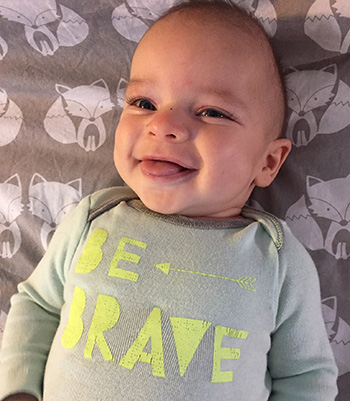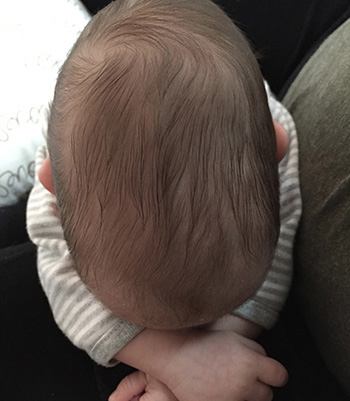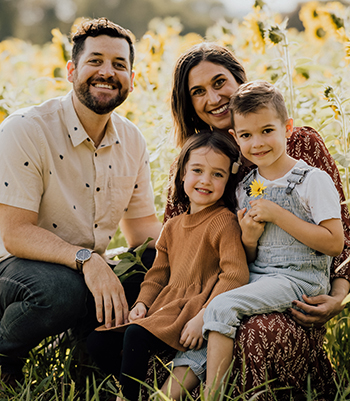Austin is Doing Well Several Years after Endoscopic Craniosynostosis Surgery
Cincinnati Family Grateful for ‘Dream Team’ of Craniosynostosis and Cranial Reconstruction Center Doctors and Nurses
After the birth of their twins, Austin and Avery, Sara and Nick Basch quickly noticed something different between them, other than their gender.
“Right off the bat, we knew Austin’s head didn't look as normal as what I would say Avery’s head looked like,” said Sara. “We watched it for a few days. We were hoping that it was just squished during delivery, but we followed up with our pediatrician to make sure."
Their family pediatrician referred Austin to Cincinnati Children’s for further evaluation. At 6 weeks old, he was diagnosed with sagittal craniosynostosis, a rare condition that interferes with the expected growth of the brain and the skull.
The condition causes two or more bones in the skull to grow together too soon. If left untreated, it can cause serious complications, including dangerous pressure on the brain.
Sara and Nick, who live in Cincinnati, knew their son needed the best care possible – as soon as possible. For them, the choice of where to get Austin treatment was obvious.
“It was always Cincinnati Children’s. We never even considered another hospital,” said Sara. "For us, it was a no-brainer. Just based on my knowledge of Cincinnati Children’s, I knew it was a great hospital, and there was no question in our mind where we would go.”
Thinking back, Sara recalls the time they were shopping for the babies' nursery, including new mattress, crib, monitor and stroller. They put a lot of time, energy and research into preparing for the arrival of their chidden and wanted to provide them with the best they could.
“We researched to the end of the internet,” said Sara, with a laugh. "But when it comes to care, we knew that Cincinnati Children's was the best. And that speaks to our confidence in Cincinnati Children’s.”
Meeting the Craniosynostosis and Cranial Reconstruction Center Team
Austin arrived at our clinic at 2 months old, and his team of doctors began formulating a treatment plan.
Things moved quickly from there. Doctors across the hospital, including ophthalmology, neurology, plastic surgery and general surgery, evaluated Austin. Given his young age and early diagnosis, they considered him an excellent candidate for the much-needed surgery.
As a Cincinnati resident, Sara said she knew about Cincinnati Children’s “world-renown” reputation. But, what she didn’t know, was what it would be like working with Austin’s care team, led by neurosurgeon Jesse Skoch, MD, and craniofacial plastic surgeon Brian S. Pan, MD. Both are co-directors of the Craniosynostosis and Cranial Reconstruction Center.
Sara admits she felt pressure to ask her questions quickly and not take up too much of the doctors’ time. “They are surgeons who are saving children's lives,” she said. “But instead, they took their time [talking with us].”
Like any parents, Sara and Nick had concerns before surgery – ranging from the effects of anesthesia to other potential risks. But the team answered all their questions and alleviated their fears.
Whether talking with Pan or Skoch, or Veronika Elsaesser, RN, coordinator for the center, Sara said she always felt comfortable and informed. The medical team collaborated and explained everything in detail, including what to expect before, during and after surgery.
“You could tell everyone was a subject matter expert. You could see them defer to each other," said Sara. “I expected the neurosurgeon to do the surgery, but then there’s also a plastic surgeon involved. I’m thinking, ‘I’ve got the dream team.’”
Surgery Performed, Austin Doing Well
A month after the family’s initial visit with Pan and Skoch, the doctors performed successful surgery – an endoscopic-assisted sagittal suturectomy. Austin was only 3 months old.
During the minimally invasive procedure, Skoch made small incisions on the top of Austin's head. This process exposed the part of the skull that had fused together, allowing him to separate the bones. Skoch then removed only the abnormal part of the skull (in a long strip under the scalp) with the aid of a small tubular camera called an endoscope.
“The skull will have a natural tendency to grow into a more normal shape when the growth restriction is removed,” said Skoch. “And we help nudge the natural remodeling process with the use of a temporary helmet or temporarily implanted springs.”
Skoch describes the surgery as an excellent alternative to more extensive reconstructive procedures for young infants, like Austin.
“Austin came to us with a dramatic elongation and narrowing of the skull (scaphocephaly). His early presentation allowed us to offer this procedure and his head shape today is an example of how a smaller surgery can often correct even a severe deformity,” said Skoch.
A few days after his surgery, Austin began wearing his specially fitted helmet. He adapted to it well and wore it consistently, 23 hours a day, for nine months (the estimated timeline for most patients is 12 months). Then, as Austin’s head grew, doctors fitted him with larger replacement helmets.
Over the years, Austin has returned to our clinic for measurement scans and to ensure all was well.
“In all of his follow-up appointments, he has never had anything look abnormal,” said Sara. “The incision is hardly a scar and is covered by his hair. It doesn’t feel like much. I’ll be forever grateful to Cincinnati Children’s and his surgery team and what they did for Austin.”
Now at 4 years old, Austin is thriving. He enjoys playing with his sister, Avery, and will continue with follow-up visits until he is 6.
“He has been doing so well, and he is such a handsome young man,” said Elsaesser. “You would never know that there had ever been a problem with his skull if you did not know his story.”
Helmets and Craniosynostosis Patients
Elsaesser offers advice to parents and caregivers about getting children used to wearing helmets:
- Babies wear helmets for 23 hours a day, with a one-hour “break” during the day. Parents can break this time up to suit their schedules. For example, they could do two 30-minute breaks, or four 15-minute breaks, etc.
- Consistency is key. Taking a baby's helmet off each time they cry only reinforces the crying behavior. During a few days’ “break-in” period, the baby might be unhappy with the helmet. But if parents consistently work through the process, the helmet will quickly become a non-issue, and the baby will tolerate the helmet well.
- Cincinnati Children’s uses helmets manufactured and adjusted by the Hanger Clinic, a national orthotic company. Our partnership enables our patients from out of state to get the same helmets and protocols as their heads grow.
- Babies who wear helmets usually go to a nearby Hanger Clinic every two to four weeks to ensure the helmet fits properly. Specialists adjust the helmet as needed to accommodate for normal head growth. Most babies in our program go through two to three helmets as their heads grow during the year.
(Published October 2021)






